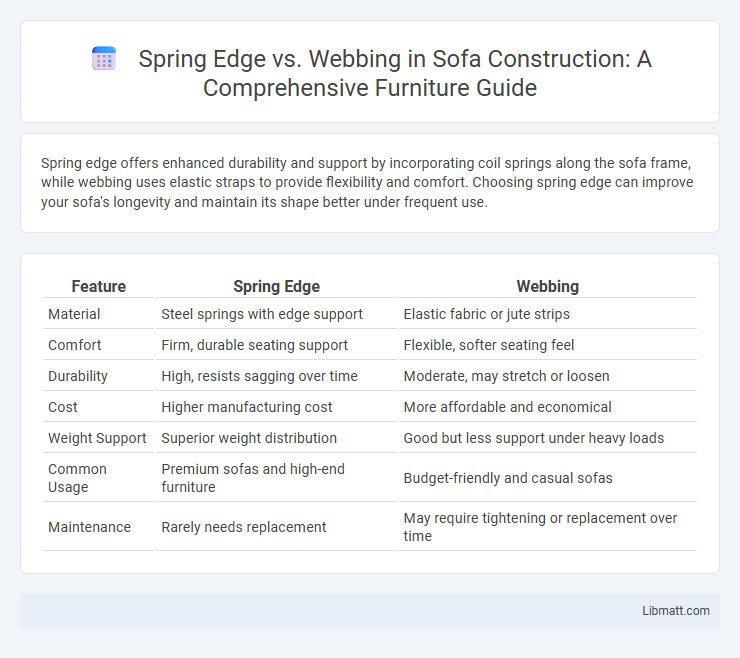Spring edge offers enhanced durability and support by incorporating coil springs along the sofa frame, while webbing uses elastic straps to provide flexibility and comfort. Choosing spring edge can improve your sofa's longevity and maintain its shape better under frequent use.
Table of Comparison
| Feature | Spring Edge | Webbing |
|---|---|---|
| Material | Steel springs with edge support | Elastic fabric or jute strips |
| Comfort | Firm, durable seating support | Flexible, softer seating feel |
| Durability | High, resists sagging over time | Moderate, may stretch or loosen |
| Cost | Higher manufacturing cost | More affordable and economical |
| Weight Support | Superior weight distribution | Good but less support under heavy loads |
| Common Usage | Premium sofas and high-end furniture | Budget-friendly and casual sofas |
| Maintenance | Rarely needs replacement | May require tightening or replacement over time |
Introduction to Sofa Construction Methods
Sofa construction methods primarily involve spring edge and webbing techniques, each affecting durability and comfort. Spring edge construction uses metal springs along the sofa's perimeter, providing enhanced support and longevity. Webbing employs strong woven straps, offering flexibility but typically less resilience compared to spring edges in high-use furniture.
What Are Spring Edge Sofas?
Spring edge sofas feature a supportive frame reinforced with steel or sinuous springs along the edges to enhance durability and maintain seat shape over time. This construction method provides superior comfort and prevents sagging by evenly distributing weight, making it ideal for heavy daily use. Compared to webbing, spring edges offer improved resilience and long-lasting performance in sofa seating.
Understanding Webbing in Sofa Design
Webbing in sofa design involves using strong, interwoven strips of fabric or synthetic material to create a supportive base beneath the cushions, providing flexibility and durability. This method enhances comfort by evenly distributing weight and allows for better airflow compared to traditional spring edge systems, reducing wear over time. Webbing is often favored for its straightforward installation and ability to maintain sofa structure without the noise or sagging associated with springs.
Materials Used in Spring Edge vs Webbing
Spring edge construction in sofas typically uses high-tensile steel coils or sinuous springs made from tempered steel, offering durable support and resilience. Webbing in sofa construction involves strong elastic straps or jute strips woven tightly across the frame to provide flexible support and comfort. These materials define the sofa's longevity and comfort level, with steel springs delivering more robust firmness and webbing offering a softer, more adaptive base.
Comfort and Support: Spring Edge vs Webbing
Spring edge systems in sofa construction provide enhanced comfort and superior support by evenly distributing weight and maintaining shape over time, reducing sagging and improving durability. Webbing, often made from elastic materials, offers flexible support but can lose tension faster, leading to less consistent comfort and reduced longevity. For premium seating experience, spring edge frameworks are preferred due to their resilience and sustained ergonomic support.
Durability and Longevity Comparison
Spring edge systems in sofa construction provide enhanced durability by evenly distributing weight and maintaining tension over time, reducing sagging and structural wear. Webbing, often made from elastic materials, offers initial comfort but may lose elasticity and stretch out faster, resulting in diminished support and shorter lifespan. To ensure your sofa withstands daily use, choosing high-quality spring edges typically guarantees superior longevity compared to standard webbing options.
Cost Implications: Which Is More Budget-Friendly?
Spring edge systems in sofa construction tend to be more budget-friendly due to lower material and labor costs compared to webbing. Webbing requires precise installation and higher-quality materials, increasing overall expenses. Opting for spring edge can provide adequate support without inflating the budget, making it the preferred choice for cost-conscious furniture manufacturers.
Maintenance and Repair Considerations
Spring edge construction in sofas requires periodic inspection and tightening of springs to maintain support and comfort, whereas webbing systems demand regular checks for sagging or fraying to prevent breakdown. Repairs to spring edges often involve reattaching or replacing individual springs, which can be labor-intensive and costly, while webbing repairs typically consist of reweaving or replacing strips, which may be simpler and less expensive. Choosing between the two depends on the ease of access to components and expected lifespan, with webbing generally offering more straightforward maintenance but potentially less durability.
Aesthetic Differences in Final Sofa Appearance
Spring edge construction in sofas offers a more uniform and resilient seating surface, resulting in a tailored and structured appearance that enhances the sofa's overall sleekness. Webbing, often used in budget-friendly sofas, can lead to a softer, less defined seat profile, contributing to a casual and relaxed aesthetic. The choice between spring edge and webbing significantly influences the sofa's final look, with spring edge sofas typically appearing more polished and durable.
Choosing the Right Option: Factors to Consider
When choosing between spring edge and webbing in sofa construction, key factors to consider include durability, comfort, and budget. Spring edge offers superior support and longevity due to its metal coil structure, ideal for frequent use and maintaining shape over time. Webbing provides a cost-effective, flexible base but may sag faster, making it suitable for light use and budget-conscious buyers.
Spring Edge vs Webbing in Sofa Construction Infographic

 libmatt.com
libmatt.com